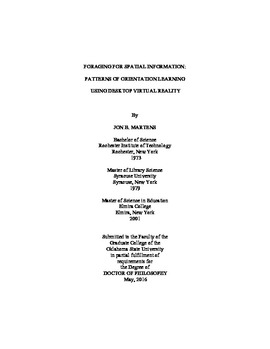| dc.contributor.advisor | Ausburn, Lynna J. | |
| dc.contributor.author | Martens, Jon B. | |
| dc.date.accessioned | 2017-02-22T22:10:07Z | |
| dc.date.available | 2017-02-22T22:10:07Z | |
| dc.date.issued | 2016-05 | |
| dc.identifier.uri | https://hdl.handle.net/11244/48844 | |
| dc.description.abstract | The purpose of the study was to provide a description of how learners use desktop VR systems for orientation learning that instructional designers could use to improve the technology. The study used a mixed method, content analysis approach based on a theoretical framework that included principles of self-regulated learning (SRL) and orientation learning. Twelve participants used desktop virtual reality (VR) systems to explore the virtual surround of a residential space. A screen-recording program captured participants' navigation movements and think-aloud verbalizations. Participants' recorded think-aloud verbalizations were coded to identify the orientation learning and SRL events they used during the session. Analysis of the participant movement data revealed that eight of the participants generally moved in a single direction through the surround, whereas the remaining four moved in a direction and then reversed that direction. Movement patterns of some participants were found to be different at the beginning and end of their VR session, and some participants tended to navigate through certain areas of the surround more slowly than through other areas. Some participants tended to view the scene at a constant field of view level, whereas other varied the level. Additionally, some participants tended to view a particular area of the scene with narrower or wider fields of view, but others varied the field of view level across the scene. A model of orientation learning events was derived from content analysis of the think-aloud transcripts showing that participants engaged in four major types of learning categories: identifying, locating, regulating, and contextualizing. Participants were classified into four groups according to relative frequency distributions of the event categories. The study concluded that use of SRL events varied amongst the participants, and that the participant used a diverse set of movement and learning event patterns. Further conclusions noted that virtual scene objects possessed meaning for learners, and that thought verbalizations indicated that some of the learners attained a sense of presence in the VR environment. Finally, the study concluded that qualitative techniques such as thought verbalizations may provide a new paradigm for measuring presence in virtual environments. | |
| dc.format | application/pdf | |
| dc.language | en_US | |
| dc.rights | Copyright is held by the author who has granted the Oklahoma State University Library the non-exclusive right to share this material in its institutional repository. Contact Digital Library Services at lib-dls@okstate.edu or 405-744-9161 for the permission policy on the use, reproduction or distribution of this material. | |
| dc.title | Foraging for spatial information: Patterns of orientation learning using desktop virtual reality | |
| dc.contributor.committeeMember | Ivey, Toni A. | |
| dc.contributor.committeeMember | Sanders, Jennifer Y. | |
| dc.contributor.committeeMember | Self, Mary Jo | |
| dc.contributor.committeeMember | Depperschmidt, Chad L. | |
| osu.filename | Martens_okstate_0664D_14560.pdf | |
| osu.accesstype | Open Access | |
| dc.type.genre | Dissertation | |
| dc.type.material | Text | |
| thesis.degree.discipline | Education | |
| thesis.degree.grantor | Oklahoma State University | |
